|
|
|
Sort Order |
|
|
|
Items / Page
|
|
|
|
|
|
|
| Srl | Item |
| 1 |
ID:
135583
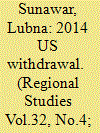

|
|
|
|
|
| Summary/Abstract |
The deployment of international troops in Afghanistan led by the US in 2001 brought new challenges for Pakistan to deal with. With American troops based in Afghanistan’s side of the border, the question of where the border was and Pakistan’s responsibilities for maintaining peace, law and order in its own territories acquired international attention. Militants were allegedly hiding on both sides of the border and were entering Pakistan through this porous border.
|
|
|
|
|
|
|
|
|
|
|
|
|
|
|
|
| 2 |
ID:
146495
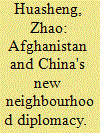

|
|
|
|
|
| Contents |
This article investigates the latest developments and changes in China's increasingly active diplomacy towards Afghanistan. This is interpreted from two perspectives. First, focusing on China's domestic perspective the author points out that under the ‘one belt, one road’ initiative, China's interests in Afghanistan have expanded, particularly in the area of transport; it has started seriously to consider Afghanistan as a transport corridor. The other perspective considers the withdrawal of US military forces and the International Security Assistance Force (ISAF) from Afghanistan in 2014, which has been followed by a critical transitional period. Concerned by these developments, China has increased its involvement and taken on more responsibilities, as demonstrated by the unprecedented frequency of Chinese senior officials’ visits to Afghanistan; the significant increase of bilateral aid to Afghanistan; and above all, the fact that Beijing has begun to coordinate negotiations between the Taliban and the Afghan government. The process of political reconciliation in the country will be extremely difficult and a quick solution is not to be expected. With regard to the idea that the Chinese are filling a ‘vacuum’ left by the US, the article argues that the so-called vacuum does not actually exist because the US military presence was temporary and the withdrawal of the US forces represents a return to the normal state of affairs. Also, excluding the US is not part of Beijing's policy in this area; rather, it is cooperating with the US and other countries in assisting Afghanistan.
|
|
|
|
|
|
|
|
|
|
|
|
|
|
|
|
| 3 |
ID:
069184
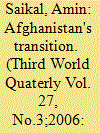

|
|
|
| 4 |
ID:
118301
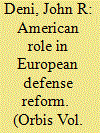

|
|
|
|
|
| Publication |
2012.
|
| Summary/Abstract |
In order to influence the direction and outcomes of defense reforms occurring across Europe, the United States needs to refocus its military-to-military engagement programs with its European allies. Instead of seeking to build partner capacity among the newest NATO members or aspirants, Washington will be better served by maintaining and strengthening interoperability with those allies that are adaptive and innovative, deployable and expeditionary, and capable of full spectrum operations-that is, allies such as France, Italy, Germany, the Netherlands and the United Kingdom. This finding is based upon what Washington itself sees as the future of conflict and the kinds of coalition partner skills and abilities the United States will need to counter post-International Security Assistance Force International Security Assistance Force (ISAF) threats to U.S. and collective security. Given budget and force structure cuts facing the United States as well, the American military cannot afford to waste its limited security cooperation resources.
|
|
|
|
|
|
|
|
|
|
|
|
|
|
|
|
| 5 |
ID:
138724
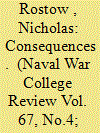

|
|
|
|
|
| Summary/Abstract |
This article examines possible consequences of U.S. and NATO withdrawal from Afghanistan, Russian annexation of Crimea and claims to territory inhabited by ethnic Russian citizens of other countries, and Chinese claims to control large adjacent areas of the Pacific Ocean. Fundamental principles of world public order are at risk or directly challenged in Afghanistan, Ukraine, and the western Pacific. They are not unique locations in this respect, but this article is not a review of all aspects of U.S. diplomacy and policy or of international relations since the end of the Cold War.
|
|
|
|
|
|
|
|
|
|
|
|
|
|
|
|
| 6 |
ID:
095956
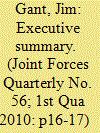

|
|
|
| 7 |
ID:
106381
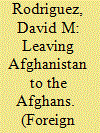

|
|
|
|
|
| Publication |
2011.
|
| Summary/Abstract |
The Afghans will indeed be ready to take over their own security by 2014, writes the former commander of the ISAF Joint Command. The size and quality of Afghanistan's armed services have increased drastically over the last few years, and the United States' decision to focus on good local governance, especially in key areas, has pacified the most important parts of the country.
|
|
|
|
|
|
|
|
|
|
|
|
|
|
|
|
| 8 |
ID:
138175
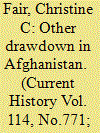

|
|
|
|
|
| Summary/Abstract |
On December 28, 2014, the combat mission of the NATO International Security Assistance Force (ISAF) in Afghanistan ended after 13 years. The transition to Afghan responsibility for security was heralded by ritually retiring ISAF’s green flag during a secret ceremony conducted in a basketball gymnasium inside the mission’s Kabul headquarters. During the event, the American ISAF commander, Gen. John F. Campbell, declared, “Our commitment to Afghanistan endures. . . . We are not walking away.” The confidence of the commander was strangely disconnected from the reality of the insurgency raging outside. After all, the ceremony was held surreptitiously out of fear: The Taliban have long been able to conduct deadly attacks at will in the capital.
|
|
|
|
|
|
|
|
|
|
|
|
|
|
|
|
| 9 |
ID:
129314
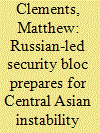

|
|
|
| 10 |
ID:
096698
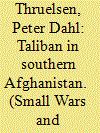

|
|
|
|
|
| Publication |
2010.
|
| Summary/Abstract |
This article gives an in-depth description and analysis of the Taliban insurgency in southern Afghanistan in 2008. It describes the local dynamics of the insurgency and argues that the Taliban should not be seen as a unified hierarchical actor that can be dealt with as part of a generic approach covering the whole of Afghanistan. The article will show that the insurgency in southern Afghanistan is highly localised in nature, being to a large extent driven by local commanders and local area networks often centred on individual commanders themselves. It will also show that the driver or cause behind the insurgency differ for the local Afghan Taliban and the foreign Pakistani Taliban respectively. The nature of the southern insurgency, with the local Taliban commanders working through local knowledge networks with a locally determined cause, implies that a strategic-level 'peace deal' with Tier I of the strategic Taliban leadership will not create the desired effect of ending the insurgency - there will not be an overall domino effect in these parts of the country.
|
|
|
|
|
|
|
|
|
|
|
|
|
|
|
|
| 11 |
ID:
082145
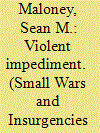

|
|
|
|
|
| Publication |
2008.
|
| Summary/Abstract |
Theorizing about Taliban operations in Afghanistan has its limits and it is possible that Kabul-centric strategies do not adequately address the unique circumstances of each region in the country. How exactly has the Taliban gone about attaining its objectives in Kandahar province and how have those approaches evolved since 2002? And how have the Taliban adapted to coalition forces' attempts to compete with the insurgency and stamp it out? The answers to these questions are critical in the formulation of any counterinsurgency approach to Afghanistan
|
|
|
|
|
|
|
|
|
|
|
|
|
|
|
|
| 12 |
ID:
106582
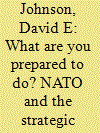

|
|
|
|
|
| Publication |
2011.
|
| Summary/Abstract |
This article examines ISAF (International Security Assistance Force) operations in Afghanistan as a way to get at the strategic disconnects in ends, ways, and means that the author believes are endemic to large-scale protracted stability and COIN (counterinsurgency) operations against adversaries who do not pose palpable existential threats to the members of an alliance. The article focuses mainly on the period that followed President Barack Obama's December 2009 announcement of a civilian and military "surge" in Afghanistan through the early stages of the ISAF offensive in Marjah, which began in February 2010. The article concludes that the fundamental strategic issue is that the Allies are not willing (or able) to devote enough resources to achieve their stated objectives. No matter how much the "Ways" might be improved, the "Means" are not sufficient to attain the "Ends." Thus, what is needed is a more realistic understanding of what ISAF can accomplish in Afghanistan and what NATO might be expected to accomplish in future operations.
|
|
|
|
|
|
|
|
|
|
|
|
|
|
|
|
| 13 |
ID:
116325
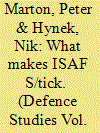

|
|
|
|
|
| Publication |
2012.
|
| Summary/Abstract |
The presented article conceptualises the issue of over- and under-contribution in coalition operations; that of how and why members of complex coalitions may be punching above and below their weight, respectively. The first section presents a parsimonious baseline assumption regarding what variables may fundamentally inform coalition burden-sharing, to subsequently discuss how much each of these are found to play a role in the context of the ISAF (International Security Assistance Force) mission in Afghanistan. The second section elaborates on this by assessing the perception and the interpretation of threats by coalition members countries, related to Afghanistan. The third and fourth sections then proceed to examine and further enrich the existing literature on coalition burden-sharing, and provide further insights regarding the ISAF operation,. Preliminary findings are presented in the fifth section where we offer raw evidence of the relevance of our baseline assumptions. In the sixth section, we present integrated models of the key variables that play a role in shaping coalition contributions, and here two key periods form the focus of this study. On the one hand, we focus on the period of ISAF's cross-country involvement in Afghanistan, following ISAF's expansion of its operations to the south of Afghanistan in mid- 2006, up to mid-2011. Subsequently, we draw conclusions as to how the distribution of countries with different approaches or "commitment postures" may have affected Afghanistan strategy and developments on the ground in the context of the ongoing insurgencies. In the final section, we refine our initial baseline assumptions and the hypothesised country profiles which were based on the latter, with reference to a recently published collection of country case studies by a team of scholars.
|
|
|
|
|
|
|
|
|
|
|
|
|
|
|
|
| 14 |
ID:
153643
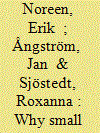

|
|
|
|
|
| Summary/Abstract |
The security behavior of small states has traditionally been explained by different takes of realism, liberalism, or constructivism – focusing on the behavior that aims toward safeguarding sovereignty or engaging in peace policies. The issue of why states with limited military capacities and little or no military alignments or engagements decide to participate in an international mission has received limited attention by previous research. In contrast, this article argues that a three-layered discursive model can make the choices of small states more precisely explained and thereby contribute to an increased understanding of small states’ security behavior beyond threat balancing and interdependence. Analyzing a deviant case of a non-aligned small state, this article explains why Sweden became increasingly involved in the North Atlantic Treaty Organization (NATO)-led International Security Assistance Force (ISAF) mission in Afghanistan. By focusing on the domestic political discourses regarding the Swedish involvement in this mission, it is suggested that a narrative shapes public perception of a particular policy and establishes interpretative dominance of how a particular event should be understood. This dominant domestic discourse makes a certain international behavior possible and even impossible to alter once established. In the Swedish case, it is demonstrated that this discourse assumed a ‘catch-all’ ambition, satisfying both domestic and international demands. In general terms, it should thus be emphasized that certain discourses and narratives are required in order to make it possible for a country to participate in a mission such as ISAF and prolong the mission for several years.
|
|
|
|
|
|
|
|
|
|
|
|
|
|
|
|
|
|
|
|
|